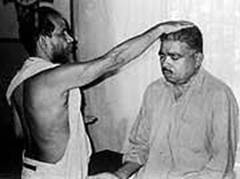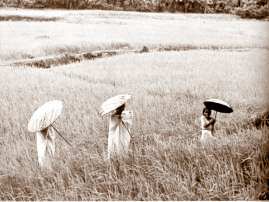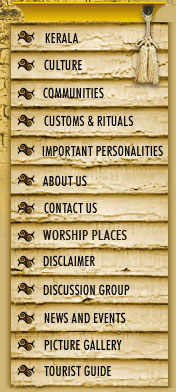|
Aachamanam
A daily practice of Brahmins to keep their body pure is known as Achamanam.
Aandupiravi (New Year)
The beginning of a new year is known as Aandupiravi. In Kerala, it is the first day of the month Chingam. In olden days, people on North Malabar were considered the first day of the month Kanni as the New Year day. Some believe that the first day of the month of Medam is the day for Andupiravi.
Acharabhasha (language used to address higher ups)
The language used by the lower caste while talking to higher caste is known as Acharabhasha.
This type of language is to be followed compulsory when conversing
with higher ups, landlords, officers, nobles and rules.
Acharakallyanam (Betrothal)
Acharakallyanam is
the betrothal marriage of Thandan community. The relatives of
bridegroom visit the bride’s residence for fixing the auspicious date
and time of marriage is the function.
Acharappanam (advance payment)
Acharappanam is the term of bride price paid to the parents of bride by the
bridegroom’s parents. Asari, Kollan (Karuvan) Kakkalan, Kallady
communities practiced the system. Once the Acharappanam is accepted, the bridegroom has right over the girl even if the marriage is not solemnised.
Achipudava (Dhothi of wife)
Achipudava is a cloth or dhothi that covers the portion below the knee. In the
past only nairs and upper class caste had the right to wear this
dress. Low castes have to wear the dress, which reach only up to
their knee.
Adhanam
This is one of the Shodashacharangal of Namboothiris. Adhanam is a rite performed as an extension of Oupaasanam and an introduction to Sroutha rites to be performed in future life.
Adiyanthiram
The function in connection with marriage and funeral are known as Adiyanthiram. Any auspicious ceremony, which includes a ritual, is called Adiyanthiram. Grand feast is an integral part of Adiyanthiram.
Akakoima (temple administrators)
A group of office bearers entrusted with the administration of temples are called Akakoima. The other two categories were Purakoimma and Melkoima. Akakoima has to concentrate on the routine affairs of the temples.
Akshara pooja (worship of letters)
 |
|
 |
(vidyarambhom). Akshara (words or letters) pooja is a function
performed on Vijayadashami day. Vijayadashami is also famous for the initiation
of children to study of alphabets. On that day every member
of the family write Harisree Ganapathaye
Namaha; Aviknamasthu
followed by vowels and consonants in the sand. After writing,
the sand is removed and placed on housetop. Instead
of sand, the practice of using rice in silver vessels
is also prevalent. The
custom of writing letters on paper and tearing of
it and placing on housetop is also there.Heavy rush is experienced for Vidyarambhom function at Thunchan Parambu at Thirur, Chittoor Thunchan Madam (the
samadhi place of Thunchathu Ezhuthachan), Sree Mookambika Temple at
Kollur (Near Mangalore), Thiruvallakkavu near Thrissur, Sarawathy
Temple, Panachikkad near Kottyam. Not only Hindus, but people
belonging to other religions also used to attend Viyarambhom function. Christians used to write Daivom Thunakkuka (God help us) instead of Hari Sri Ganapathaye Namaha; Aviknamasthu. Muslims write verses from Qur’an on the right hand palm with black ink on a day before Bakrid festival.
 |
Ambalapuzha Palpayasam (Milk pudding of Ambalapuzha)
Ambalapuzha Palpayasam is the famous offering of the Sree Krishna Temple of Ambalapuzha. It can be identified by its taste from other payasams.
It has distinct off white colour and fragrance. In the
morning milk measured and boiled. By the noon boiling milk will almost
convert in the form ghee. Then the other ingredients – rice and sugar
added. The payasam so prepared is offered to the Lord during noon pooja.
Ammakazcha and Appakazcha (presentation of cakes, sweets etc)
On the 7th day after marriage, parents of bridegroom send appam (special rice cakes made of molasses, coconut, ghee and other sweet
ingredients) to the bride’s house. This ritual is known as Ammakazcha. In return, parents of bride send appam and other recipe to the bridegroom’s house on the 14th day after the marriage, is known as Appakazcha. Paraya community follows these rituals.
Aparakriya / Seshakriya (After death rituals)
Aparakriya is the ritual to be performed by the hirers of a deceased person from his cremation day to the end of pula (death pollutuion).
Ammayiyappam (Sweet Recipes from Mother-in-law)
When
a mother visits the house of her son-in-law for the first time, she has to bring special
food items with her. This was an unavoidable custom of earlier
period. This was known as Ammayiyappam. Ammayiyappam food packet will contain sweets such as Neyyappam, Pottiyappam, kunhikalathappam, kuzhalappam and ripened nendran banana.
Rich mothers brought the items in large vessels and other in
baskets. This custom was prevalent in Tellichery and Kannur
areas of Malabar.
Ammayiyonam (Onam with Mother-in-law)
In the matrilineal family there was a system to bring the wife to the house of the husband on the Avittam asterism day during onam festival. This practice was in force
in Valluvanad Taluk of Malabar. The day was celebrated as Ammayiyonam.
Angam (Duel)
When disputes between people were not solved by the Tharakootam (the local assembly) or Nattukoottam (the assembly of a desom or taluk), it was sorted out in open fight by members of special
community. This ancient custom prevalent in Kerala was known as Angam.
Annaprasanam (first rice feeding ceremony)
Annaprasanam is one of the Shodashacharangal of Namboothiris. Annaprasanam is the Choroonu,
the first rice feeding ceremony. The child is served with a mixture
of ghee and honey, followed by rice. It is performed after six months of child's birth.
Anthiuzhichil (Removal of Evil Spirits)
A
ritual performed to remove evil spirit(s) from the body. The
leaf of ‘koovalam’ is be put in a vessel containing a solution of
lime and turmeric. A lit wick will be taken in hand. Firstly
seven uzhichil (turning vessel around the head of the person infected with evil spirit) were taken with the vessel. Later the wick will
be placed in the edge of vessel and the uzhichil will be repeated for
seven times. After that the solution with the wick and leaf will
be poured out in the northern end of house plot and the empty vessel
placed up side down.
Anuloma Vivaham (Marriage with a lower caste)
Anuloma Vivaham is the practice of wooing a low caste woman by a man of higher
caste. It was not prohibited in ancient Kerala, but marriage of lower caste man with a woman of higher caste (Prathiloma Vivaham) was prohibited.
Arppu vili (Shouting of happiness)
It
is an expression of happiness on the birth of male child. The
words “Aarappee…ire….” are shouted when Arppu vili is done. It is also done during marriage and other happy occassions.
Arathamuzhiyuka
Arathamuzhichil
is a function performed on the arrival of bridegroom to the house of
bride after marriage and vice versa. The eldest female member of the
family will mix lime and turmeric in a vessel and make it as red
colour. A lit wick will be placed on the banana leaf.
Using the vessel and wick, the bridegroom / bride will be subjected to uzhichil (waiving the vessel) three times. After
that the contents of the vessel will poured out at a distance
place. The purpose of this ritual is to safeguard the
bridegroom/bride from evil spirits.
Ashatamirohini (birth day of Lord Krishna)
The day in the month of Chingam (August-September) when ‘Ashtami’ and ‘Rohini’(an asterism day) comes together is known as Ashtamirohini.
This is birthday of Lord Krishna. It is also known as
‘Janmashtami’. Special poojas, functions were conducted in the
temples of Lord Krishna.
Ashirvadam (Blessing)

Ashirvadam is the blessings given by elders and Gurus to those who bow before them on auspicious occasions.
Ashta Mangalyam (Eight Holy Materials)
Ashta (eight) mangalyam (holy occasion) consists of
eight articles that carried on a large metal plate or bronze vessel
for offerings. Asta mangalyam are prepared in different ways.
(1) Rice, paddy, tailed mirror, sandal, reddish kumkum, khajel, Grandh
(book) and washed clean cloth. (2) Nira (paddy), Nazhi (rice),
mirror, flower vessel, vilakku (small holy lamp), adorned girl, gold.
(3) Paddy, rice, betel wine, areca nut, coconut, jaggery, banana and
vilakku (small holy lamp). (4)Nirapara, Vilakku, mirror, gold,
coconut, curd, book, cheppu (small pot). Brahmin, cow, fire, gold,
ghee, adithyan (sun), water, king are also considered as
Ashtamanglyams.
Ashtaka
A ritual performed by the Namboodiris to please their ancestors is known as Ashtaka. It is a type of ancestral worship.
Ashtangangal (eight practices of Kath Kali)
Keli, Arangukeli, Thodayam, Vandanaslokam, Purappad, Melappadam, Kadhabinayam and Dhanasi are the Ashtangangal. Keli is the practice of informing the public about the staging of Kath Kali by using the musical instruments viz., chenda, maddalam, ilathalam and chengila. By hearing the sound of these musical instruments, which is known as ‘Kelikottu’, people are aware of the Kath Kali performance. This is the first function of Kath Kali dance. Arangukeli is also known as ‘Sudha Maddalam’. It begins as soon as the light is lit on the stage. The beating of maddalam and ilathalam will be carried out for ten minutes and after that the curtain will
be raised. In the beginning two characters start their
performance. It is the Thodayam. Music and drums without chenda will also there. This is performed as prayer for the trouble free performance of Kath Kali. Vandanaslokam is a song chanted by the singers in the end of Thodayam. In some stories, Vandanaslokam is performed after Arangukeli avoiding Thodayam. After Vandanasokam, the first stanza of the story will be chanted, which is known as Purappad. After that the actor and actress appear to the stage. All
allowable types of musical instruments will be played. With
this, the curtain will be lowered. After Purappad, Melappadam begins. The ‘Manjuthara’ of “Geetha Govindam” will be sung. This is also known as ‘Manjuthara’. Chenda and maddalam are used. The initial procedure of Kath Kali will end with ‘Manjuthara’. After that the main actor enters on the scene and starts Kathabhinaya (perform Kath Kali). When the Katha Kali performance end Mangalaslokam (final stanza) will be chanted. This is known as Dhanasi, which makes the end of Kath Kali.
Ashtavivahangal (Eight types of marriages)
Brahmam: The practice where father gives his daughter to a Brahmachari (bachelor) without any reward. Daivam: Father gives his daughter to a priest with gold ornaments. Aarsham: Father gives his daughter after accepting cows and bullocks. Prajapathyam: Father gives his daughter to man by saying “You may live with her by observing code rules”. Gandharvam:
A lover takes his lady without consulting the relatives and performs
the rituals. Aasuram: Here a man buys a woman from her parents. Rakshasam: The practice of taking a girl by force after defeating here parents and relatives. Paishacham: Here a girl is forcefully made as wife when she is unconscious.
Athamchadurthi (Vinayaka Chadurdhi)
It is also known as Chadurdhi Ganapathy or Vinayaka Chadurdhi. It comes during full moon period during the month of Chingom (August-September), on the Atham asterism day. It is believed that on that day one should not look at the moon in the sky.
Athazhapooja (Worship at evening)
Athazhapooja is an oblation in temples performed at evening before the close of inner shrine. This will be the last pooja of the day. It is also known as “Thiruvathazham”.
Athyavasyam kodukkuka (Giving essentials)
The
custom of giving essential items for dressing, bathing, frying and
cooking to the wife house by the husband during the eve of Onam and
Vishu festivals. This custom was prevalent in the matrilineal
society. The status of women was assessed depending on the quantum and
value of the materials so received.
Avarohanam (crowning)
Avarohanam means to perform “sthanarohanam” which denotes the crowning to a position.
Avil Nivedyam
Avil (beaten rice) Nivedyam (offering) is a famous offering for Hanuman in the Tripayar Sreerama
Temple. It is an important offering in Vedivachankoil of
Trivandrum-Nagarcoil Road. The avil nivedyam of
Kucheladinam (day observed as a mark of respect to Kuchela, the
class-mate of Krishna) is a main offering of the Sri Krishna Temple at
Guruvayoor.
Ayitham (untouchability)

Nair girl (right extreme) accompanying Brahmin ladies keeping the stipulated distance.
Ayitham was a malevolent custom prevalent in the society during the rigidness of caste system. The word Ayitham means dirt. The people belonging to upper caste practiced this
to the lower caste. Not only touch but even passing nearby
also caused Ayitham. Fixed distance between each caste
was there to keep away from the upper caste. When a Nair touch
or pass near by a Brahmin it would cause Ayitham. Immediate bathing is the only solution. The funeral will also cause Ayitham. A person who has already touched a low caste happens to touch another, would also cause Ayitham. Ayitham by seeing a lower caste person was also prevalent. ‘Mannan’ and
‘Panan’ castes have to give way to Theeyas/Izhavas. ‘Pulayan’ and
‘Parayan’ have to give way to ‘Mannan’ and ‘Panan’. A low caste
person should not go near a pond where higher caste persons take
bath. If he or she goes it will cause Ayitham to the higher
caste. Logan says that Nayadis, Pulayans, Kanisans and Mukkuvans
should keep 72 feet, 64 feet, 32 feet and 24 feet respectively from
upper class. Every one took special care not to cause Ayitham.
When Nambooiris and their ladies walk, the helpers will make loud
noise like “yahe…. yahe….” or “ho…ho…” as a warning to the lower caste
to keep awary from their path. This practice was known as
‘Theendappad’. Lower caste people also practised the same
custom. They will shout “aey…aey…” so that the upper caste will
keep away from the path. They considered this as their duty. The low
caste had no right to go near the bathing place of upper caste.
The males should not look at the female who had their menses.
Separate seats were provided in schools for the children belonging to
lower caste. Nobody except Brahmins had the right to worship in
temples by ringing the bell. The doctors belonging to the same
caste had the right to treat the patient. Namboodiries can marry
Nair girls, but should not touch the children born in such
ladies. Even the dead bodies would be subjected to Ayitham if touched by lower caste. To identify the low castes easily, it was
ordered that they should keep their body portion above waist as
naked. They should not wear any kind of special dress, footwear,
umbrella or ornaments. Only the Brahmins had the right to carry
umbrellas. Other should not carry umbrellas even if it rained
heavily. A low caste woman will take off her cloth from shoulder
to show respect to a higher caste. Women observed the custom and
practice more rigidly. Naboodiries can eat the food prepared
by the Kshathriya but their women cannot. In the Nair communiy men
used to take food from outside but their females cannot. In early
stages both the higher and lower castes had a general belief and
understanding about these practices. They considered these
practices as a part of the day-to-day life like taking food or
bath. But during later stages, matters have changed. The low
cast turned against and protested against considering them as
low. They quarreled, sued and shouted. The higher caste still
observed Ayitham. Modern generation may think that
these are fabricated stories. But they are real facts. Today
there is no such evil practice like Ayitham is observed. Its observance is a criminal offence now.
 |
Ayudhapooja (Worship of tools)
A
function organized during Navarathri. The implements and weapons
will be placed for the blessings of the god. Not only
implements, but books will also be placed for pooja. The pooja will start on the day of Durgashtami and end on Vijayadashami day. Ayudhapooja or Saraswathypooja is observed during Thulam (September-October) every year.
Ayyappanpattu (Song of Lord Ayyappa)
A function organised in connection with the Sabarimala pilgrimage. Pilgrims do this before they start their pilgrimage to the hills. It is also known as “Pattum Vilakkum” (Song and Lights).
Azhichattam (jumping over fire pit)
Azhi is a fire pit with full ofember and hot stones. The oracles, devotees and poojaris (priests) jump in the fire pit barefoot. It is believed that the fire will not cause any burn to them.
|



